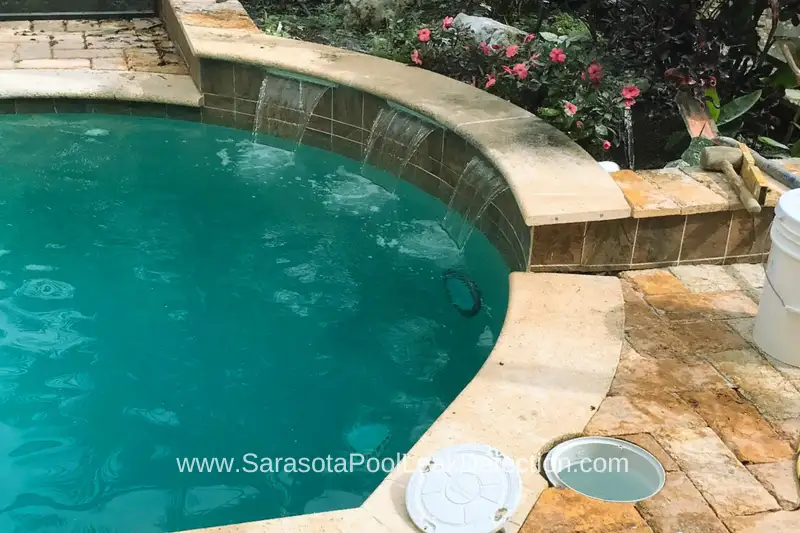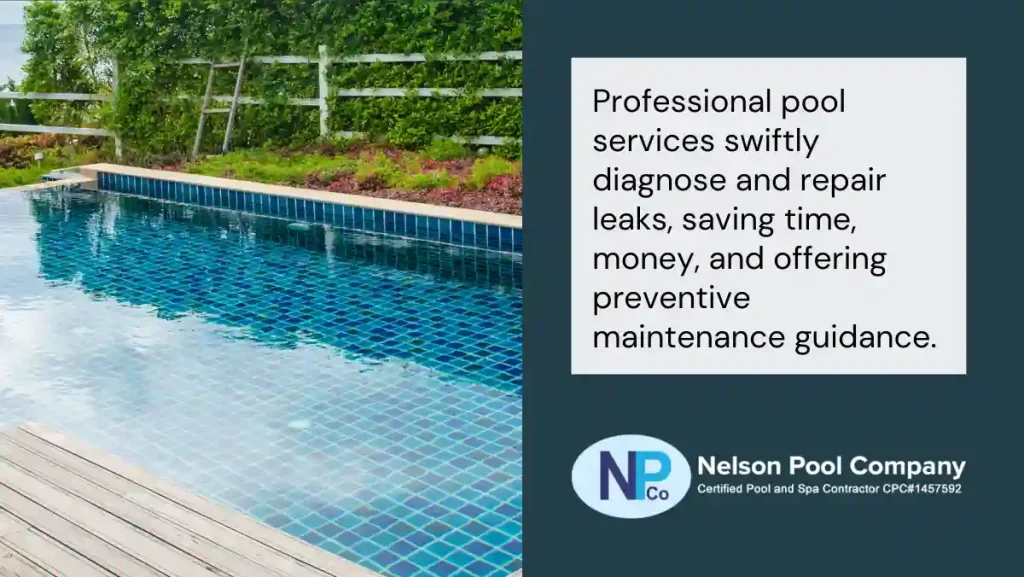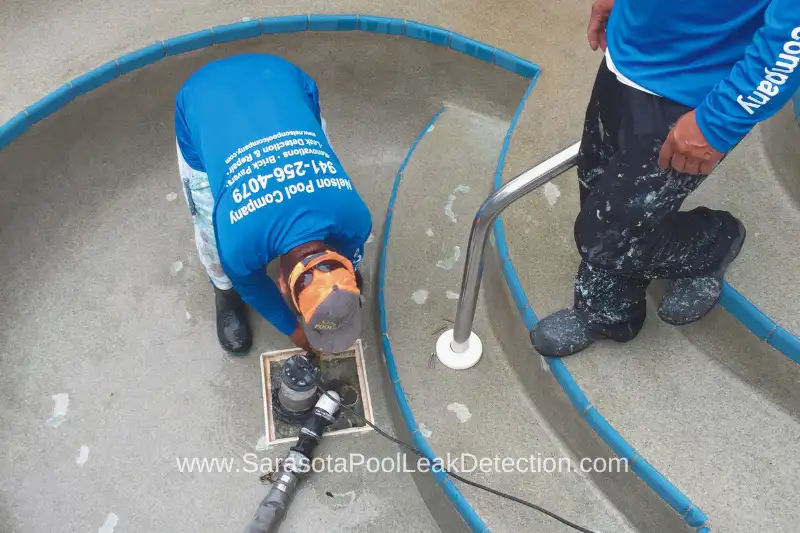Addressing pool leaks promptly is crucial to maintaining your pool’s integrity and avoiding costly repairs.
Ignoring a leak, even a small one, can lead to significant water loss, structural damage, and increased utility costs. It can also disrupt the chemical balance of your pool, making it unsafe for use. Early detection is critical, and there are several signs to watch out for.
A sudden drop in water level, unexplained soggy spots in the surrounding area, cracks or visible damage to the pool lining, and an unusual increase in your water bill all indicate a potential leak.
By being vigilant and responding swiftly to these warning signs, you can ensure your pool remains a safe and enjoyable part of your home.

How to Identify a Pool Leak
Identifying a pool leak early can save you from extensive and expensive repairs in the future. Here’s how you can spot a leak and confirm its existence.
Common Signs of a Pool Leak
Loss of Water at an Abnormal Rate: It’s natural for pools to lose some water due to evaporation and splashing, but a significant drop in water level over a short period is a red flag. Keep an eye on the water level; if it decreases faster than usual, it might indicate a leak.
Curious if it’s a leak or just evaporation? Explore our guide on Sarasota pool leak detection for clarity and expert insights.
Wet Spots Around the Pool Area: Noticeable wetness in the area surrounding your pool, especially in patches where it shouldn’t be, can be a sign of escaping water. These soggy spots can even lead to mold or mildew growth, signaling a persistent leak.
Cracks or Gaps in the Pool Structure: Visible cracks in the pool lining, tiles, or concrete are not just cosmetic issues. They can be pathways through which water escapes. Regular inspections for such damages can help catch a leak early.

Unexplained Increase in Water Bills: If your water bills have spiked unexpectedly and significantly without any known increase in usage elsewhere, it could be due to a leaking pool silently adding to your water consumption.
The Bucket Test
To confirm a suspected leak, you can perform a simple but effective “Bucket Test”:
- Fill a Bucket: Fill a standard bucket with pool water to about an inch from the top.
- Place the Bucket in the Pool: Set the bucket on a pool step (ensure it’s submerged at least a few inches). Mark the water level inside the bucket.
- Mark Pool Water Level: Also mark the pool’s water level on the outside of the bucket or on the pool wall.
- Wait 24 Hours: Avoid using the pool for the next 24 hours. If your pool has an auto-refill feature, turn it off.
- Compare Water Levels: After 24 hours, compare the water level inside the bucket to the water level outside (in the pool). If the pool water level has decreased more than the water inside the bucket, it indicates a likely leak.
Following these steps, you can determine whether your pool leaks and needs further investigation or professional repair.
How To Locate the Leak
Once you have identified a potential leak, the next step is to pinpoint its location. This can be a tricky process, but by methodically inspecting common leak areas and using DIY methods, you can often locate the source of the leak yourself.
Inspecting Common Leak Areas
Skimmers: Start with the skimmer, a common site for leaks. Check for cracks or gaps in the skimmer itself. Inspect the seal where the skimmer meets the pool wall; separation can lead to leaks.
Drains: Examine the main drain at the bottom of the pool. Ensure the cover is intact, and the seal around the drain isn’t compromised. Sometimes, the leak might be in the pipe leading to the drain, which can be more challenging to detect.
Lights: Pool lights can also be a leak source. Water may seep through the conduit that holds the wiring for the light. Check for any moisture or water inside the light fixture.
Pool Lining: Look for tears or separations for vinyl liners, especially along seams and around fittings like return lines and steps. In concrete pools, check for cracks or gaps in the plaster.
Discover the most common pool leak areas in our comprehensive guide on Sarasota pool leak detection.
DIY Methods for Leak Detection
Using Food Coloring: A simple method to locate small leaks is using food coloring. First, ensure the water is calm. Then, squirt some food coloring near a suspected leak area. If there’s a leak, the colored dye will be drawn towards it, revealing its location. This method works best for leaks in the pool’s lining or near fittings.
Leak Detection Kits: There are also commercially available leak detection kits. These kits typically include dye testers and sometimes even more advanced tools like hydrophones (underwater microphones) to listen for leaks. They often come with detailed instructions and can be a great option if you’re struggling to locate the leak with more rudimentary methods.
By carefully inspecting common leak areas and utilizing DIY methods, you can often locate the source of the leak. If these methods do not reveal the leak, or if the leak is in a location that’s not easily accessible, it might be time to call in a professional.

What to Do If Pool is Leaking?
Once you’ve successfully located a pool leak, it’s time to consider the best course of action for repairs. Depending on the nature and severity of the leak, you might opt for a DIY solution or decide to call in professional help.
DIY Repair Solutions
Patch Kits for Minor Leaks: Patch kits can be an effective solution for small leaks, especially in vinyl liners. These kits usually include a piece of vinyl and a unique adhesive that works underwater. It’s crucial to follow the instructions carefully to ensure a watertight seal.
Precautions for DIY Repairs: When attempting DIY repairs, it’s essential to prioritize safety. Ensure the pool is drained to a safe level if needed, and never dive into a partially filled pool. Always use products specifically for pools to avoid further damage or safety hazards. If you’re not confident in your ability to perform the repair, it’s best to seek professional help.

When to Call a Professional
Scenarios for Professional Help: Professional intervention is necessary if the leak is in a hard-to-reach place, like underground plumbing or deep within the pool’s structure. Also, if your initial repair attempts don’t hold or you’re dealing with multiple leaks, it’s time to call in the experts.
Benefits of Hiring a Pool Repair Service: Professional pool repair services have the expertise, tools, and experience to diagnose and fix leaks, no matter how complex quickly. They can ensure that repairs are done correctly, saving you time and money. Additionally, professionals can provide valuable advice on maintaining your pool to prevent future leaks.
You can choose the right repair option by assessing the nature of the leak and your capabilities. Whether you tackle the repair yourself or hire a professional, the goal is to get your pool back to its best condition as soon as possible.
How to Prevent Future Leaks
Prevention is vital when it comes to pool leaks. By engaging in regular maintenance and considering long-term solutions, you can significantly reduce the likelihood of future leaks and prolong the life of your pool.
Regular Maintenance Tips
- Routine Checks and Cleaning: Regularly inspect your pool for signs of wear and tear, such as cracks or loose tiles. Clean your pool frequently to prevent the build-up of debris, which can lead to blockages and strain on the pool’s systems.
- Monitoring Water Levels and Chemical Balance: Keep a close eye on the water level, as drastic changes can indicate a leak. Also, maintain the correct chemical balance in your pool. Improperly balanced water can corrode materials and lead to leaks over time.
Long-term Solutions
- Investing in a Pool Cover: Using a pool cover can reduce evaporation, debris collection, and unnecessary strain on your pool when not in use. It also helps maintain the chemical balance by reducing contamination, thus protecting the pool’s structure.
- Periodic Professional Inspections: Some problems can go unnoticed even with diligent maintenance. Regular professional inspections can help identify and address potential issues before they become significant leaks. Pool experts can advise your specific pool type and usage patterns.
Please include attribution to https://sarasotapoolleakdetection.com with this graphic.
Adopting these preventative measures can help ensure that your pool remains a source of enjoyment rather than a cause for concern. Regular maintenance and strategic long-term solutions are crucial to avoiding leaks and keeping your pool in optimal condition.
Tackling pool leaks early is crucial for the longevity and enjoyment of your swimming pool. As highlighted in this guide, addressing leaks promptly can prevent extensive and expensive damage in the future. Ignoring what might seem like a minor issue can lead to more severe consequences, including structural damage and inflated utility costs.
Being proactive in your pool’s maintenance is essential. Regular inspections, timely maintenance, and awareness of the signs of leaks are critical steps in ensuring your pool’s health. Remember, the care you invest in your pool provides functionality, extends lifespan, and ensures safety.
Whether handling minor repairs or facing more complex challenges, taking the proper steps is essential. If you’re unsure about any aspect of pool maintenance or need expert assistance, don’t hesitate to contact Nelson Inda Pool Company. Our team of professionals is ready to help you with all your pool care needs. Call us at (941) 256-4079 to ensure your pool remains a source of joy and relaxation for many years.
Curios about the most common above ground pool leaks? Learn more about effective solutions with Nelson Pool Company in Sarasota.
